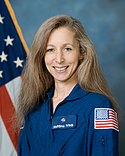Marsha Ivins
| Marsha Ivins | |
|---|---|
 | |
| Land: | USA |
| Organisation: | NASA |
| ausgewählt am | 23. Mai 1984 (10. NASA-Gruppe) |
| Einsätze: | 5 Raumflüge |
| Start des ersten Raumflugs: | 9. Januar 1990 |
| Landung des letzten Raumflugs: | 20. Februar 2001 |
| Zeit im Weltraum: | 55d 21h 48m |
| ausgeschieden am | 31. Dezember 2010 |
| Raumflüge | |
Marsha Sue Ivins (* 15. April 1951 in Baltimore, Maryland) ist eine ehemalige US-amerikanische Astronautin.
Ivins erhielt 1973 einen Bachelor in Luft- und Raumfahrttechnik von der University of Colorado. Anschließend arbeitete sie ab Juli 1974 bis 1980 als Ingenieurin am Johnson Space Center der NASA, unter anderem an der Entwicklung eines Displays für das Space-Shuttle-Cockpit. Ab 1980 wurde sie als Technikerin für das Shuttle Training Aircraft und als Copilotin für das administrative Flugzeug der NASA, eine Gulfstream 1, eingesetzt.
Astronautentätigkeit

Ivins bewarb sich erfolglos für die neunte Astronautengruppe der NASA. Im Mai 1984 wurde sie jedoch mit der zehnten Gruppe angenommen und anschließend zur Missionsspezialistin ausgebildet.
STS-32
Mit der Raumfähre Columbia flog Ivins am 9. Januar 1990 zum ersten Mal ins All. Zu den Hauptaufgaben des Fluges gehörte das erfolgreiche Aussetzen des Nachrichtensatelliten Syncom IV-F5 und das Bergen der Forschungsplattform LDEF mit dem Roboterarm.
STS-46
Ivins startete mit dem Space Shuttle Atlantis am 31. Juli 1992 zur Mission STS-46. Während des achttägigen Fluges wurde der Satellit EURECA ausgesetzt sowie Erprobungen mit dem Tethered Satellite System (TSS) durchgeführt.
STS-62
Am 4. März 1994 startete Ivins mit der Raumfähre Columbia zu ihrem dritten Weltraumflug. Nutzlast waren die United States Microgravity Payload 2 (USMP) und Office of Aeronautics and Space Technology 2 (OAST). Mit diesen Nutzlasten konnten die Auswirkungen der Schwerelosigkeit erforscht werden.
STS-81
Am 12. Januar 1997 flog Ivins mit der Raumfähre Atlantis zur Raumstation Mir. Im Mittelpunkt standen der Materialtransport und der Wechsel eines Besatzungsmitgliedes. Wissenschaftliche Experimente befanden sich im Mitteldeck der Fähre, andere waren in einem Spacehab-Doppelmodul untergebracht.
STS-98
Ihre letzte Mission führte sie am 7. Februar 2001 mit der Raumfähre Atlantis zur Internationalen Raumstation (ISS). Dabei wurde das US-Raumlabor Destiny zur ISS gebracht und dort montiert. Außerdem wurde ein Andockstutzen versetzt und Versorgungsgüter für die erste Langzeitbesatzung mitgebracht.
Siehe auch
- Liste der Raumfahrer
- Liste bemannter Missionen zur Raumstation Mir
- Liste der bemannten Raumflüge
- Liste der Space-Shuttle-Missionen
- Liste bemannter Missionen zur Internationalen Raumstation
Weblinks
- Kurzbiografie von Marsha Ivins bei spacefacts.de
- Biografie von Marsha Ivins in der Encyclopedia Astronautica (englisch)
- NASA-Biografie von Marsha Ivins (englisch; PDF)
- Marsha Ivins in der Internet Movie Database (englisch)
| Personendaten | |
|---|---|
| NAME | Ivins, Marsha |
| ALTERNATIVNAMEN | Ivins, Marsha Sue |
| KURZBESCHREIBUNG | US-amerikanische Astronautin |
| GEBURTSDATUM | 15. April 1951 |
| GEBURTSORT | Baltimore, Maryland |
Auf dieser Seite verwendete Medien
The crew patch for STS-81 , the fifth Shuttle-Mir docking mission, is shaped to represent the Roman numeral V. The Shuttle Atlantis is launching toward a rendezvous with Russia's Mir Space Station, silhouetted in the background. Atlantis and the STS-81 crew spent several days docked to Mir during which time Jerry M. Lineger (NASA-Mir-4) replaced astronaut John Blaha (NASA-Mir-3) as the U.S. crew member onboard Mir. The U.S. and Russian flags are depicted along with the names of the shuttle crew.
STS-62 Mission Insignia
STS-32 Mission Insignia
- The STS-32 patch, designed by the five crewmembers for the January, 1990 space mission, depicts the Space Shuttle orbiter rendezvousing with the Long Duration Exposure Facility (LDEF) satellite from above and the Syncom satellite successfully deployed and on its way to geosynchronous orbit. Five stars represent the mission number with three on one side of the orbiter and two on the other. The seven major rays of the sun are in remembrance of the crewmembers for STS 51-L. In preparation for the first Extended Duration Orbiter (EDO) missions, STS-32 conducted a number of medical and middeck scientific experiments. The caduceus on the left represents the medical experiments, and the crystalline structure on the right represents the materials science. The crew is comprised of Astronauts Daniel C. Brandenstein, James D. Wetherbee, Bonnie Dunbar, Marsha S. Ivins, and G. David Low.
STS-46 Mission Insignia
Astronaut Marsha S. Ivins, mission specialist
This is the insignia for STS-98, which marks a major milestone in assembly of the International Space Station (ISS).
- Atlantis' crew will deliver the United States Laboratory, Destiny, to the ISS. Destiny will be the centerpiece of the ISS, a weightless laboratory where expedition crews will perform unprecedented research in the life sciences, materials sciences, Earth sciences, and microgravity sciences. The laboratory is also the nerve center of the Station, performing guidance, control, power distribution, and life support functions. With Destiny's arrival, the Station will begin to fulfill its promise of returning the benefits of space research to Earth's citizens.
- The crew patch depicts the Space Shuttle with Destiny held high above the payload bay just before its attachment to the ISS. Red and white stripes, with a deep blue field of white stars, border the Shuttle and Destiny to symbolize the continuing contribution of the United States to the ISS. The constellation Hercules, seen just below Destiny, captures the Shuttle and Station's team efforts in bringing the promise of orbital scientific research to life. The reflection of Earth in Destiny's window emphasizes the connection between space exploration and life on Earth.






